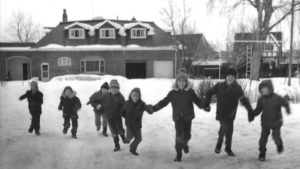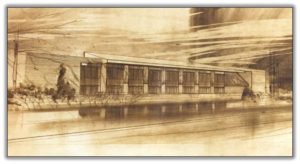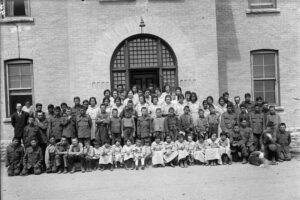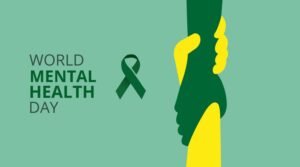Broadview Village began as a children's home
(Click headings to see more or less)
The story of Broadview Village began in 1825 with John Taylor, a native of Staffordshire, England, who purchased a farm in the Village of Todmorden’s Don Valley after moving from Cherry Valley, New York. The Village of Todmorden (at the junction of what is now Pottery Road and Broadview Avenue) was in full growth. A grist mill had been built in the valley by Parshall Terry, was later converted to a saw mill and then to a paper mill. In the 1840’s, John Taylor and his sons purchased the York Paper Mill which stood where Todmorden Mills Historic Site is now located. They were persuaded by George Brown of the Globe to open another mill and built one two miles above the York Paper Mill on the Don in 1847. In 1858 they built a third paper mill half way between the first two. This is the only one of the mills still operating and is now a Domtar Mill. By 1861 all three mills were operating with approximately 10 employees each and by 1877 one hundred employees worked in the three mills. As the Taylor family legacy continued to prosper into the 1900s they began building large homes above the valley.
 Chester Park (1132 Broadview Avenue), was one of these homes. Thomas Taylor Jr. built a home in the early 1880’s for his mother and younger brothers and sisters to live in following his father’s death (Thomas Taylor 1811-1880). In 1887 or 1888 Mrs. Thomas Taylor and her family moved to Toronto and the 28 ½ acres Chester Park was sold to Robert Davies (son-in-law of George Taylor). Robert Davies then built a home in the orchard of Chester Park for his recently married son Norman who resident there until he sold it to The Salvation Army on November 20 1940.
Chester Park (1132 Broadview Avenue), was one of these homes. Thomas Taylor Jr. built a home in the early 1880’s for his mother and younger brothers and sisters to live in following his father’s death (Thomas Taylor 1811-1880). In 1887 or 1888 Mrs. Thomas Taylor and her family moved to Toronto and the 28 ½ acres Chester Park was sold to Robert Davies (son-in-law of George Taylor). Robert Davies then built a home in the orchard of Chester Park for his recently married son Norman who resident there until he sold it to The Salvation Army on November 20 1940.
 The Story of Chester Park enter a new phase on January 15, 1941 when The Salvation Army turned the 75 year old, 21 room red brick mansion into a home to support 35 children called The Nest. At the time of The Nest’s opening there were 32 girls ranging in age from 5 to 19 years. The Nest’s mission was to provide children care, guidance and education in preparing them to earn a living at the age of 16 or 17. In the mid 1960’s the first boy was admitted and the name of the program changed to The Salvation Army Children’s Home.
The Story of Chester Park enter a new phase on January 15, 1941 when The Salvation Army turned the 75 year old, 21 room red brick mansion into a home to support 35 children called The Nest. At the time of The Nest’s opening there were 32 girls ranging in age from 5 to 19 years. The Nest’s mission was to provide children care, guidance and education in preparing them to earn a living at the age of 16 or 17. In the mid 1960’s the first boy was admitted and the name of the program changed to The Salvation Army Children’s Home.
As the needs increased The Salvation Army decided new facilities were required. In 1962 the first cottage was officially opened and by 1967 two more had been built. With the three cottages and the Coach House used to accommodate the children, the age of the mansion began to show. The old house was no longer feasible to accommodate children. The original red brick house was slowly deteriorating and it was decided in the 1970s to have it demolished and a new one built. With the help of a generous donation from Mr. Harry and Mrs. Margaret Newman, a new administration building officially opened on April 10th, 1976.
Community living for people with developmental disabilities
(Click headings to see more or less)
 By 1975 a new need was on the horizon that would forever change The Salvation Army Children’s Home. A movement had been growing to move people with developmental disabilities out of institutions and into community living. The Salvation Army Children’s Home changed its name to The Salvation Army Broadview Village and set a new mission to serve and meet the needs of Children with Development Disabilities.
By 1975 a new need was on the horizon that would forever change The Salvation Army Children’s Home. A movement had been growing to move people with developmental disabilities out of institutions and into community living. The Salvation Army Children’s Home changed its name to The Salvation Army Broadview Village and set a new mission to serve and meet the needs of Children with Development Disabilities.
In February 1975, phase I of a new program was implemented to accommodate 10 developmentally challenged adolescents. During the months of July and August of the same year phase II of the new program was made available for the Developmentally Challenged. By July 1976 Phase III was in place making the maximum of 30 beds available. During this time of transition, residents from the Children’s Home days continued to live at Broadview Village until the time was right for them to move on to the next stage of their lives.
As the new generation of children moved into Chester Park, Broadview Village continued to maintain the standards of excellence set before them. There were no challenges that could not be overcome.
On the Residential living side, many of the children continue to live at the Village as adults. As the needs of the developmental community changed, so did Broadview. The need for more residential support also increase. In response Broadview Village expanded outside of 1132 Broadview purchasing its first house on Oriole Parkway in January 1983. In April 1985 Broadview expanded again and rented a home on Briar Hill Ave. Broadview used this house until 1990 when it was sold by the owners. This lead to the purchase of the Spruce Hill Road house located in the Beaches. In October 1987 another House was purchased on Ridley Blvd. This home was focused to help the residents who live there greater develop their independent living skills.
Recently Broadview Village has grown again opening the Tambrook homes in March 2017 and Hancock and Meldazy Homes in March and May of 2018.
Meanwhile, as the children grew into adulthood, a new problem arose…
 Included on the property is the beautiful bricked building called The Coach House. This building was used for the servants and for the storage of buggies for the Taylor and Davies families. The Coach House still stands today and is all that remains of the residence Thomas Taylor’s family built in 1880. A monument to the legacy and contribution of the Taylor and Davies family, (who were responsible for much of the development of East York) The Coach House of Chester Park was issued a historical plaque by the East York Historical Society on June 11, 1986.
Included on the property is the beautiful bricked building called The Coach House. This building was used for the servants and for the storage of buggies for the Taylor and Davies families. The Coach House still stands today and is all that remains of the residence Thomas Taylor’s family built in 1880. A monument to the legacy and contribution of the Taylor and Davies family, (who were responsible for much of the development of East York) The Coach House of Chester Park was issued a historical plaque by the East York Historical Society on June 11, 1986.
 Up to 1993 all the residents living at Broadview Village had been attending school. As they began reaching adulthood, their day program referrals were rejected leaving them with no meaningful activity during the day. In July 1993 Broadview Village responded by creating a Day Program of their own providing day time activities for both Broadview residents and some from the outer community as well. From the lower level of the Coach House, this new Day Program supported their participants doing various activities to improve their fine and gross motor skills, provide life skills training and leisure play. They practiced pre-vocational tasks and focused on communication and social skills. Once again as the needs became greater The Salvation Army responded. The little day program running out of Coach House that served 16 people eventually moved to Railside and became the Broadview Village Enrichment Program (BVEP) and currently serves over 80 people. But the story did not stop there. In 2015 BVEP opened a satellite Day Program in the Main Administration Building at Broadview Village. In 2017 BVEP returned to their roots and open a small Day program in the Basement of The Salvation Army West Hill Corps. The Program opened supporting 5 people, but is looking to grow and no doubt will.
Up to 1993 all the residents living at Broadview Village had been attending school. As they began reaching adulthood, their day program referrals were rejected leaving them with no meaningful activity during the day. In July 1993 Broadview Village responded by creating a Day Program of their own providing day time activities for both Broadview residents and some from the outer community as well. From the lower level of the Coach House, this new Day Program supported their participants doing various activities to improve their fine and gross motor skills, provide life skills training and leisure play. They practiced pre-vocational tasks and focused on communication and social skills. Once again as the needs became greater The Salvation Army responded. The little day program running out of Coach House that served 16 people eventually moved to Railside and became the Broadview Village Enrichment Program (BVEP) and currently serves over 80 people. But the story did not stop there. In 2015 BVEP opened a satellite Day Program in the Main Administration Building at Broadview Village. In 2017 BVEP returned to their roots and open a small Day program in the Basement of The Salvation Army West Hill Corps. The Program opened supporting 5 people, but is looking to grow and no doubt will.
Serving adults with mental health challenges and/or dual diagnosis
(Click headings to see more or less)
 The early 1960’s saw significant breakthroughs in the development of psychiatric medications for the treatment of mental illness. For the first time symptoms which made life so difficult for people could be controlled. Those who had previously been confined to hospitals were now able to return to community life. Unfortunately, the general stigma of mental illness was still strong in the community and this new development did not ensure the acceptance of or support for people with mental illness.
The early 1960’s saw significant breakthroughs in the development of psychiatric medications for the treatment of mental illness. For the first time symptoms which made life so difficult for people could be controlled. Those who had previously been confined to hospitals were now able to return to community life. Unfortunately, the general stigma of mental illness was still strong in the community and this new development did not ensure the acceptance of or support for people with mental illness.
The Founder and The Sheltered Workshop
Against this background in 1969 Lieut. Colonel Stanley Preece, a Salvation Army Officer, came up with a unique idea. Using a church basement on Toronto’s Lisgar Street, Lieut. Colonel Preece started a small sheltered workshop and hired people with mental health challenges to repair damaged wooden crates. Now there was a place that provided those with mental health challenges work, income, friendship and support. The basement shop program, known as The Sheltered Workshop, would become the seed for all The Salvation Army’s mental health services in the Greater Toronto Area.
The Sheltered Workshop grew as different kinds of job opportunities became available and in order to accommodate this the program moved to 2 Matilda Street in 1971. Now the people attending were assembling and packaging products for community businesses.
The Day Care Workshop
In 1977 as the need in the community grew again and 2 new programs were created. A second smaller workshop called The Day Care Workshop was opened off of Bathurst Street to support those who found working in the larger setting too difficult.
Dufferin Residence
Next the Army addressed a new problem. Though these workshops provided much needed support and work, many attending them were struggling due to difficult and impoverished living conditions. In response, The Salvation Army opened Dufferin Residence to provide safe, supportive and affordable housing for up to twenty-three people.
In 1979 The Sheltered Workshop moved from Matilda Street to 143 Lakeshore Blvd. East, expanding once again to meet the growing need allowing space to support 160 people.
Booth Industries, Bathurst Industries & The Transitional Employment Program
In 1984 a series of rebranding began as The Sheltered Workshop became Booth Industries and the Day Care Workshop changed to Bathurst Industries. But as work continued, a new service gap became evident. A growing number of workshop participants expressed a desire for competitive employment. They wanted a chance to learn more skills and work more in the community. To address this Booth Industries created the Transitional Employment Program (TEP) in 1986. This was a vocational program providing participants with work opportunities, training and support. Real work for real pay. TEP allowed participants to expand their skills while receiving counseling and job coaching. It was a huge success and still operates to this day.
People Learning Useful Skills Program
As need continued to increase, the Army continued to respond. In 1986, Bathurst Industries moved to 177 Lakeshore Blvd. East, then to Scarborough in 1990 and finally landed in North York at 150 Railside Rd in 2001 where it rebranded itself as the People Learning Useful Skills Program (P.L.U.S Program). Booth Industries moved to Islington Ave. in the west end of Toronto in 1997, and then up the street in 2012 to a new building also rebranding itself as Booth Packaging and Supportive Services (BPSS).
Booth Supportive Services
In 2006 Dufferin House was renamed Liberty Housing and Support Services. With the buildings at 248 and 250 Dufferin St being approximately 100 years old, The Salvation Army proposed to provide “wrap around service” to people supported in the community. Working closely with the Local Health Integrated Networks a new program was opened in the fall of 2011 called Booth Supportive Services.
More change was on the horizon. On January 1, 2015 the four mental health agencies were merged to form one umbrella agency called The Salvation Army Toronto Mental Health Services. However, as new challenges and barriers increased a decision was made in 2016 to merge the P.L.U.S, TEP and BPSS programs with The Salvation Army Broadview Village. Both benefited greatly from the merger allowing more services to more people.
The Affirmative Business
Changes did not stop there as a growing concern identified that people working in sheltered workshops were not being paid a fair wage. This resulted in the Ontario Government mandating the closure of all shelter workshops.
Not all people who were accessing the Shelter workshops were happy with the new direction. They received value in the work they were doing and wanted to continue. This sparked the creation of The Affirmative Business, a vocational program for people coping with mental health challenges doing competitive work for real wages.
Community Engagement and Pre-Employment Program
Booth Packaging and Supportive Services reinvented itself as the Community Engagement and Pre-Employment Program (CEPE Program) serving both people with mental health challenges and people with developmental disabilities who have higher learning needs. The CEPE Program helps people who are not work ready but would like to participate in their community and develop their social and life skills.
The P.L.U.S. Partnership continues the legacy of the P.L.U.S Program supporting adults coping with mental health challenges by teaching new and supporting current vocational skills.
TEP continues encouraging and empowering the people they support towards sustaining good mental health and emotional well-being and providing meaningful contributions to society.
In 1969 work began in a church basement from the vision of one man. This now serves over 250 people in programs across the Greater Toronto Area. While the program has grown, the original purpose remains – to offer support, encouragement and assistance to those with mental health challenges helping them live productive and meaningful lives in the community.






 Red Dress Day, also known as the National Day of Awareness for
Red Dress Day, also known as the National Day of Awareness for 
 Pongal (
Pongal (

































































